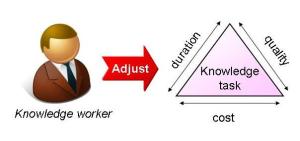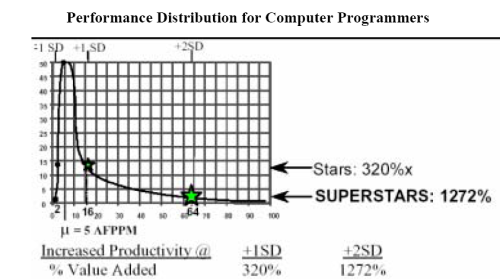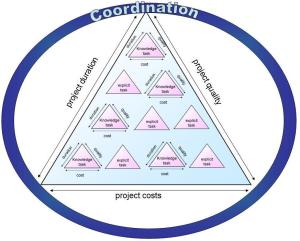I thought some years ago that Enterprise information system growth was more or less linear, according to a size factor. But getting experience, I soon discovered that inserting a new application in an existing information system comes to the same thing of creating a kind of turbulence which will take several months before to be stabilized.
Indeed, when counted in a stabilization process, applications may undergo several changes which do not change their initial function points count. Also when enterprises acquire or reengineer some of their information system parts, they use to implement COTS which are difficult to assess in function points. It results that measuring information system size is allways difficult and, even done, it will be a poor predictor for change which is rather related to business optimisation pace.
Then, the productivity question darken because it means that Function Point/number of people may not be a reliable indicator. Let’s talk a little bit about productivity.
Even if a lot of IT Divisions work is mapped with processes, they are rather objectives with milestones than true totally defined steps and rules. It is up to knowledge worker to meet milestones according to an approach he has selected on his owns. However, some IT Divisions have well enough defined some of their processes to be done by regular worker, like help desk, or demand management. It means that they reach enough maturity to be able to control all specific cases.
According to strategic interest, IT Divisions may decide to make some process explicit for being automated and performed by regular workers. Nevertheless, some of them, like architecture management, are hard to be totally define. Core IT Divisions processes rely on knowledge workers.
Famous Peter Drucker say is “To make knowledge work more productive will be the great management task of this century, just as to make manual work productive was the great management task of the last century.” (Age of Discontinuity, 1978)
Knowledge worker have to decide according to deadline, requirements, constraints, and other tasks to be undertaken by other knowledge workers, of the task duration, task cost and task quality. Even a complex task may be done very quickly when required information is found, or required decision is taken. Time and efforts are often spent in information search, Analysis, Decision making, Planning, all tasks having an uncertain productivity.
Knowledge workers have another specificity : the gap between top performers and average performer is very large. Spencer found that in Construction engineering top performers are 360% more productive than average ones. But in IT, top performers are sixteen fold more productive than average ones. It means that CIO have more incentive than other managers to transform their average performers in top ones.
But to be efficient, knowledge workers have to be not only experts of their domain, but able to collaborate with others inside the organisation for managing gloabl processes. Collaboration is a critical factor of success for an organisation of knowledge workers. They should have an excellent social ability, but they need tools to empower it : it is Web 2.0.
Managers may be uneasy with this since there is no drivers with direct link to process results which could be played with, allowing to control the process. Here drivers are indirect and control of processes is included in knowledge worker work. Instead of controlling processes themselves, Managers have to control knowledge workers for that they need to pay attention to following drivers :
| Methods : Processes Organisational: |
Personal: – Motivation – Job satisfaction – Personal network – Affairs in personal life – Physical fit – Organisation of work – Division of tasks – Organisation of decision making – Clarity of job descriptions – Teamwork – Knowledge sharing – Delays and waiting – Ability to affect own work – Innovations – Quality – Utilisation of innovations – Time-efficiency – Fulfilment of customer’s expectations |
CIO should accept the challenge of managing knowledge worker in an appropriate way. Even if he has to invest each year to make process explicit for being performed by regular workers, new processes and new tasks due to new technologies coming, appear and need to be handled by knowledge workers.
In short, IT division productivity measure could only be global. It is difficult to find evidence on how each IT division part contributes.
To be able to boost productivity, CIO should help knowledge workers to improve their expertise. An effective competence management seems to be a good way with a goal of increasing top performers. A good news is that top performers may be hired from suppliers which allow to boost temporarily IT Division productivity and improve internal workers competences.
Spencer, L.M. “Competency Psychology.” St. Augustine, Florida: Spencer Research & Technology, 1997Inputs
Process



